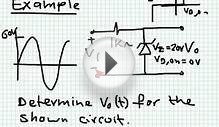A diode is a specialized electronic component with two electrodes called the anode and the cathode. Most diodes are made with semiconductor materials such as silicon, germanium, or selenium. Some diodes are comprised of metal electrodes in a chamber evacuated or filled with a pure elemental gas at low pressure. Diodes can be used as rectifiers, signal limiters, voltage regulators, switches, signal modulators, signal mixers, signal demodulators, and oscillators.
The fundamental property of a diode is its tendency to conduct electric current in only one direction. When the cathode is negatively charged relative to the anode at a voltage greater than a certain minimum called forward breakover, then current flows through the diode. If the cathode is positive with respect to the anode, is at the same voltage as the anode, or is negative by an amount less than the forward breakover voltage, then the diode does not conduct current. This is a simplistic view, but is true for diodes operating as rectifiers, switches, and limiters. The forward breakover voltage is approximately six tenths of a volt (0.6 V) for silicon devices, 0.3 V for germanium devices, and 1 V for selenium devices.
The above general rule notwithstanding, if the cathode voltage is positive relative to the anode voltage by a great enough amount, the diode will conduct current. The voltage required to produce this phenomenon, known as the avalanche voltage, varies greatly depending on the nature of the semiconductor material from which the device is fabricated. The avalanche voltage can range from a few volts up to several hundred volts.
When an analog signal passes through a diode operating at or near its forward breakover point, the signal waveform is distorted. This nonlinearity allows for modulation, demodulation, and signal mixing. In addition, signals are generated at harmonics, or integral multiples of the input frequency. Some diodes also have a characteristic that is imprecisely termed negative resistance. Diodes of this type, with the application of a voltage at the correct level and the polarity, generate analog signals at microwave radio frequencies.
Semiconductor diodes can be designed to produce direct current (DC) when visible light, infrared transmission (IR), or ultraviolet (UV) energy strikes them. These diodes are known as photovoltaic cells and are the basis for solar electric energy systems and photosensors. Yet another form of diode, commonly used in electronic and computer equipment, emits visible light or IR energy when current passes through it. Such a device is the familiar light-emitting diode (LED).
RELATED VIDEO


